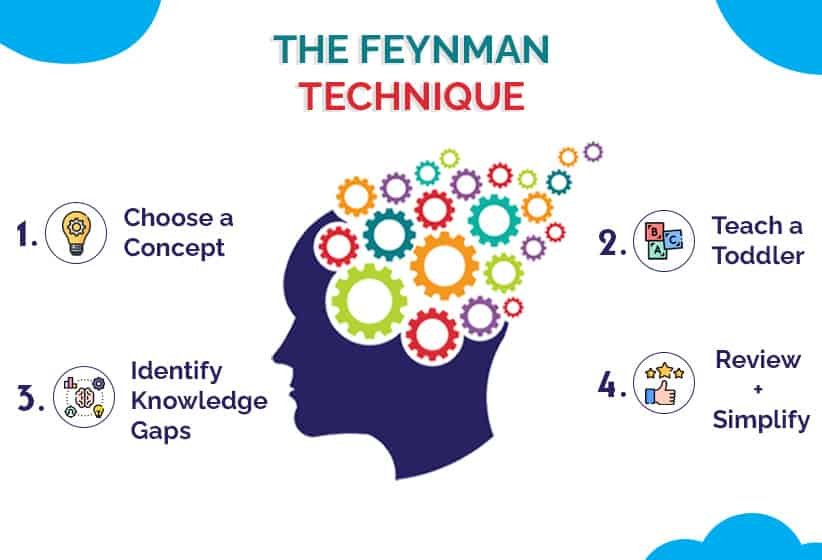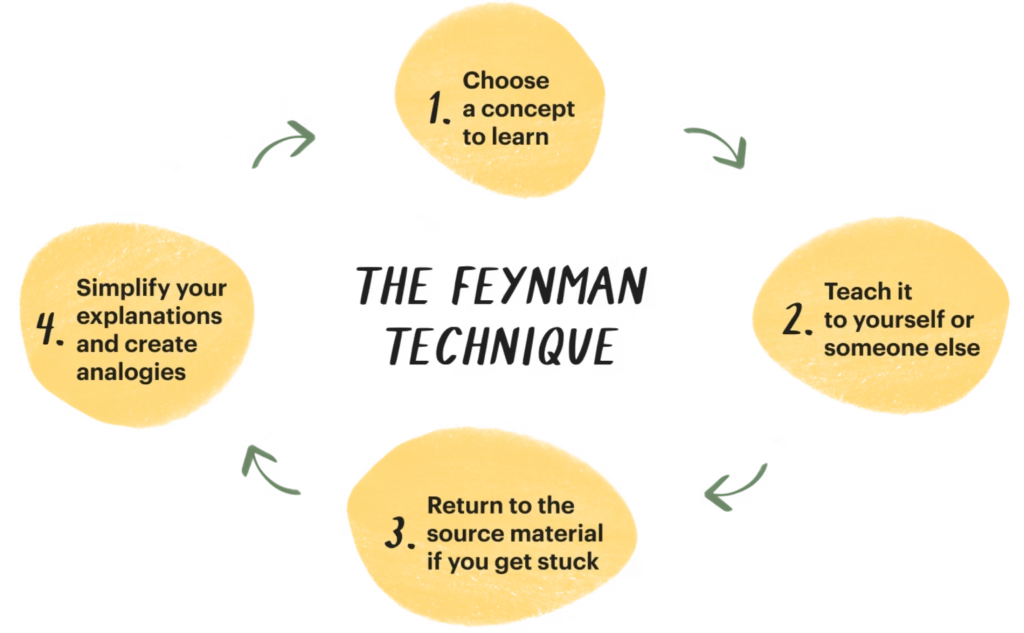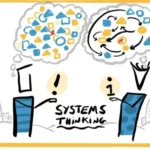The Feynman Technique is named after Richard Feynman, a Nobel Prize-winning physicist who had this uncanny ability to explain ridiculously complex ideas (like quantum mechanics!) in a way that even a 12-year-old could kinda grasp.
The heart of his technique?
If you can’t explain it simply, you don’t really understand it.
That’s it.
Honestly, when I first heard that, I rolled my eyes. Sounded too good to be true. But now I’m on the Feynman train for good.
Step 1: Use the Feynman Technique to Explain a Concept to a 10-Year-Old
Let’s say you’re trying to learn blockchain. (Yeah, I know… dense stuff.)
So what you do is this:
Grab a blank page and write at the top: “What is Blockchain?”
Now — without looking at any articles or notes — write down what you know, like you’re teaching a curious 10-year-old. No fancy words. No buzzwords. Just you, your brain, and a very confused imaginary kid.
Mine went something like this:
“Blockchain is kind of like a notebook that everyone shares. But once you write something in it, you can’t erase it. Everyone sees it, and everyone has a copy.”
Kinda shaky, right? But that’s the point — it shows you where you’re unsure. You’ll catch those “umm… wait, why does that happen?” moments.
And those are gold. Seriously. That’s where learning begins.

Step 2: Use the Feynman Technique to Find Gaps and Relearn
So now you’ve written what you think you know.
Time to check where you stumbled.
When I first did this with machine learning, I realized I had no idea how a model actually trains. I could throw around words like “neural nets” and “regression,” but ask me to explain it like I’m talking to my aunt over tea?
Nope. Total failure.
So I went back to my sources (YouTube, blog posts, random Reddit threads — whatever worked) and dug into just the fuzzy parts. That’s the key. You don’t have to start over — just patch the holes.
Then — and this is important — I rewrote my explanation.
Step 3: Use the Feynman Technique to Tell the Story Again — Simpler This Time
Now that you’ve filled in some gaps, try explaining it again.
This time, make it even more like a story. Use metaphors, comparisons, whatever works.
Honestly, this step makes me feel like a teacher — and weirdly, I kinda love it.
When I re-explained cloud computing to myself, I wrote something like:
“It’s like you used to store all your photos in photo albums at home. But now, you keep them in a giant online photo locker that you rent space in. You don’t have to worry about losing the album. Someone else takes care of it, and you can look at your photos from anywhere.”
Boom. Way easier. And guess what? Saying it like that helped me understand it better too.
Step 4: Use Analogies. Dumb Ones. They Work.
I used to think I needed to sound smart. Like, all the tech jargon, buzzwords, acronyms — throw them in, right?
Nope. Not with Feynman.
The dumber your analogy, the better your brain holds onto it.
Learning about API integrations? Don’t say “a middleware communication bridge between applications.”
Ew. Try this instead:
“It’s like a waiter in a restaurant. You tell the waiter what food you want, they go to the kitchen and get it. You don’t deal with the kitchen directly.”
That? That sticks.
Even now, when I think of APIs, I picture a tired waiter holding a tray. And it makes me laugh. Which… helps me remember it.
Human brains are weird like that.
Real Talk: This Isn’t a Speedrun
Look, the Feynman Technique isn’t some cheat code to download knowledge like Neo in The Matrix.
It takes time. It takes effort. And — I’m not gonna lie — it can be frustrating.
Sometimes I’ll sit there staring at a sentence I wrote like:
“Why do I sound like I know nothing??”
But that’s the good part.
That moment right there? That’s where the real learning happens. Not when you nod along to a YouTube tutorial. But when you feel the confusion and fight through it.
Also: don’t be afraid to talk out loud. I walk around my room talking to my walls about tech concepts like a mad scientist. It works.
Why It Works (My Very Non-Scientific Opinion)
There’s something powerful about “teaching” an idea — even if no one’s listening.
It’s like your brain is forced to organize the chaos. When you explain something simply, you’re turning abstract mush into a concrete thought. And once you do that — it sticks.
Plus, it makes you confident.
The next time someone asks, “Hey, how does cloud storage actually work?” you won’t freeze.
You’ll tell them about the photo locker thing.
And you’ll sound like a genius.
Use It For Anything — Not Just Tech Stuff
I know I’m a tech nerd, but this works outside of tech too.
- I used it to understand my friend’s explanation of the stock market (spoiler: it’s just organized gambling sometimes).
- I used it to explain meditation to my cousin.
- Heck, I used it to help myself understand how the freaking dishwasher cycle works.
Anything complex — anything you find intimidating — try putting it through the Feynman filter.
Conclusion
Look, learning hard things isn’t about being the smartest person in the room.
It’s about being curious enough to wrestle with ideas until they make sense to you.
The Feynman Technique isn’t flashy. It’s kinda messy. You’ll feel silly at times.
But it’s real. It works. And honestly? It feels good. Like, really good.
When you finally explain a thing clearly — to yourself or someone else — you feel smarter, stronger, and more connected to the world around you.
Read our more blogs-(PKS) Build a Personal Knowledge System That Works


